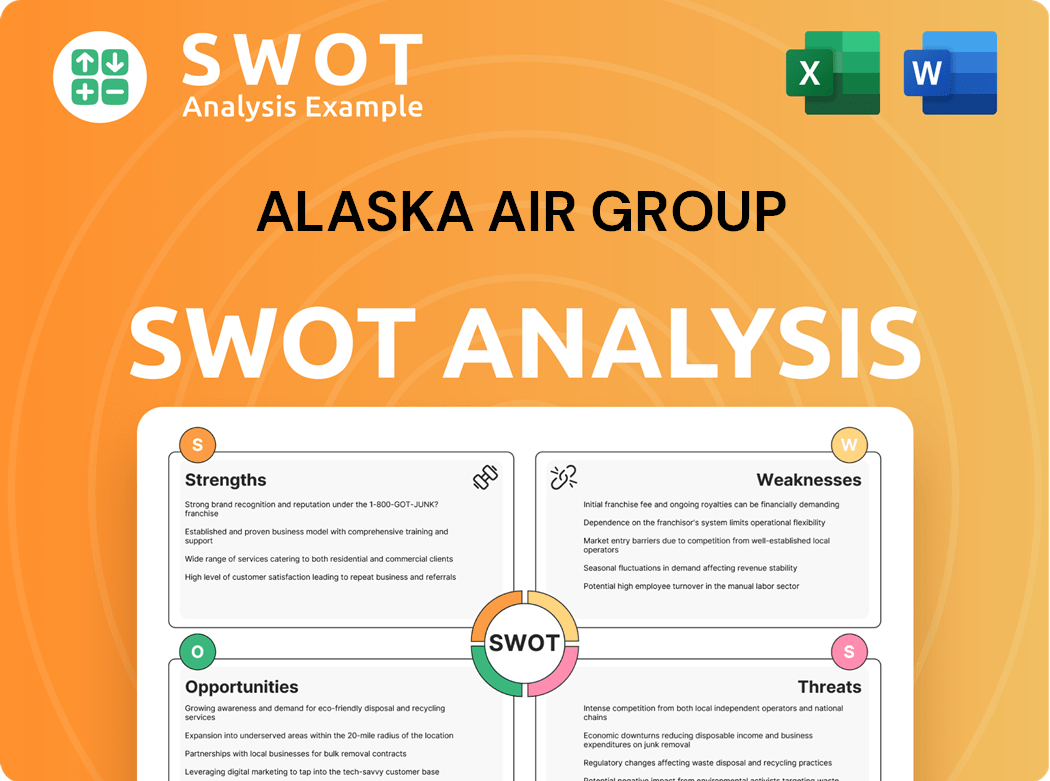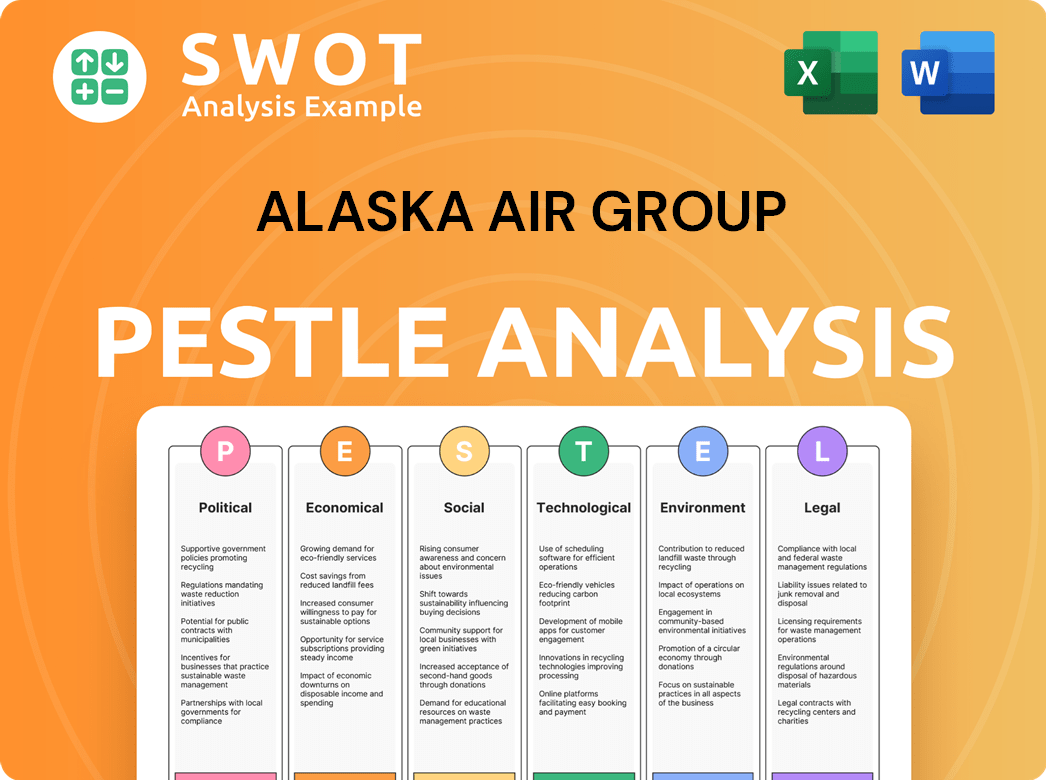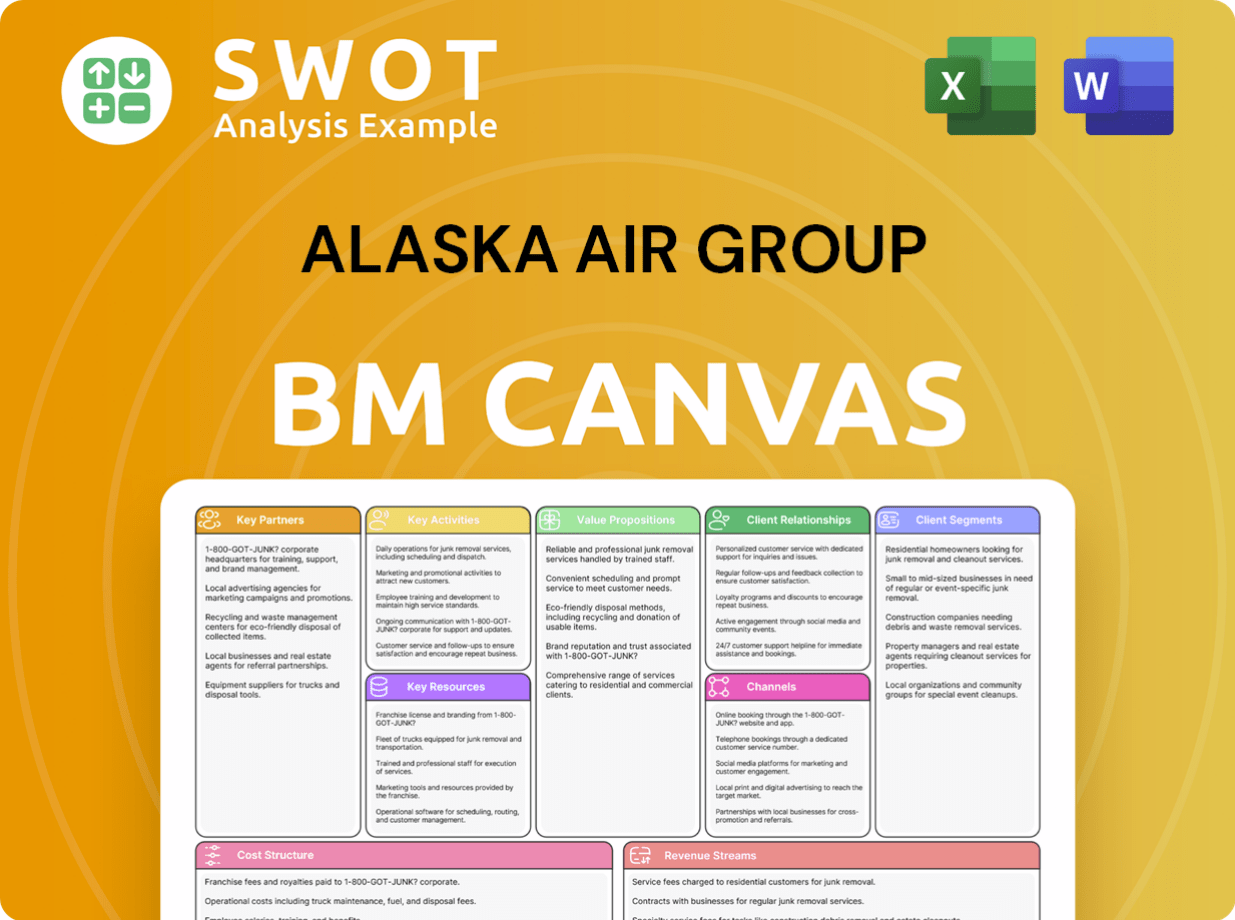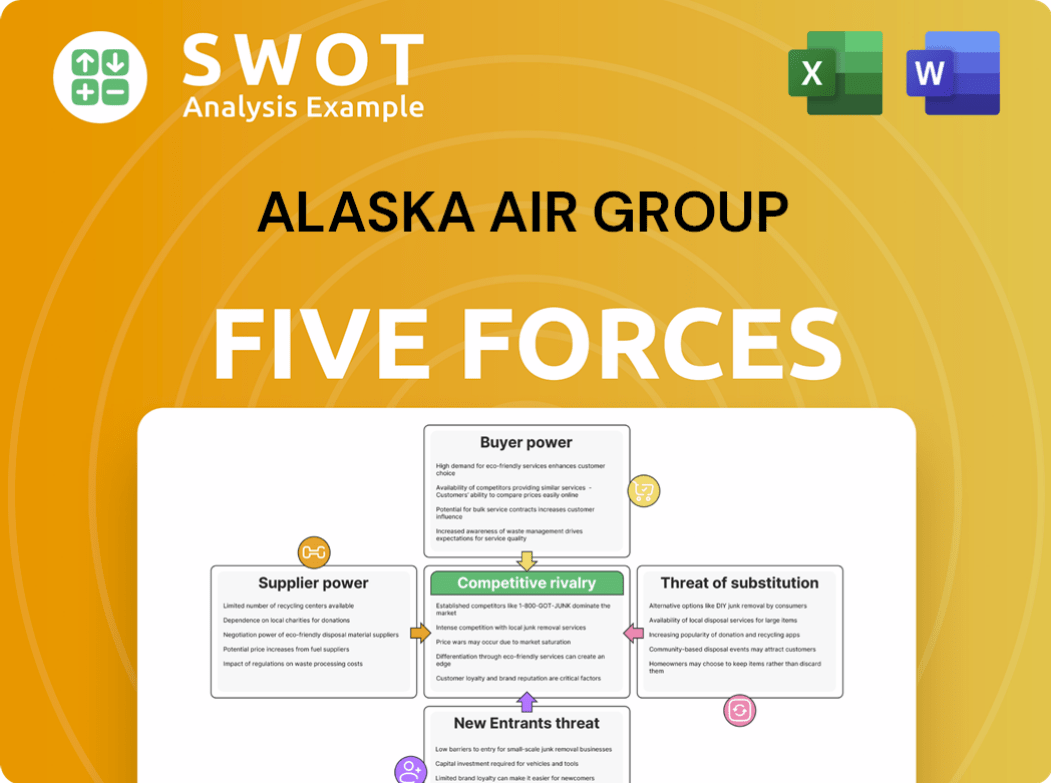Alaska Air Group Bundle
Can Alaska Air Group Soar to New Heights?
Alaska Air Group, a key player in the dynamic Airline Industry, is currently undergoing a significant transformation, highlighted by its strategic acquisition of Hawaiian Airlines in 2024. This pivotal move is reshaping the company's growth trajectory, aiming to establish a more robust presence across the U.S. and beyond. From its humble beginnings in 1932, Alaska Airlines has evolved into a major force, and now faces exciting new challenges and opportunities.

With the integration of Hawaiian Airlines underway, understanding Alaska Air Group's Alaska Air Group SWOT Analysis is crucial for investors and strategists. The company's future hinges on its ability to navigate the complexities of the market and capitalize on its expanded reach. This analysis will delve into Alaska Airlines' expansion plans, financial performance, and competitive landscape, providing actionable insights into the future of Alaska Airlines stock and its growth opportunities.
How Is Alaska Air Group Expanding Its Reach?
Alaska Air Group's expansion strategy is heavily influenced by its acquisition of Hawaiian Airlines. This strategic move allows for significant network enhancements and entry into new markets, particularly focusing on international routes and improved service offerings. The company is leveraging this acquisition to broaden its reach and improve its competitive position within the airline industry.
A key component of the expansion includes establishing Seattle as a major international gateway. This strategic positioning aims to capitalize on Seattle's location to facilitate connections to Asian markets. The integration of Hawaiian Airlines is also expected to boost cargo revenue, with ambitious plans to double revenue in this area over the next few years. This expansion is part of a broader plan to enhance overall financial performance and market share.
The 'Alaska Accelerate' strategy, launched post-Hawaiian Airlines acquisition, targets $1 billion in incremental pretax profit by 2027. This growth is projected through a combination of commercial initiatives and operational synergies. This strategic approach demonstrates a commitment to long-term growth and profitability within the dynamic airline industry.
Alaska Air Group is planning to launch new nonstop flights from Seattle to Tokyo Narita and Seoul Incheon in 2025. The company aims to expand to at least 12 international widebody destinations by 2030. This expansion utilizes Hawaiian Airlines' widebody aircraft fleet, including Airbus A330s and Boeing 787s.
The company is focusing on enhancing its product and service offerings. This includes expanding premium seating capacity and upgrading airport lounges. A new premium credit card is expected to launch in the summer of 2025. These improvements aim to enhance the overall customer experience.
Alaska Air Group aims to become Hawaii's trusted airline by improving network connectivity. It plans to offer a loyalty program tailored for Hawaiian residents. This strategy is designed to strengthen its presence and customer loyalty within the Hawaiian market, contributing to sustainable growth.
The integration of Hawaiian Airlines is expected to significantly boost cargo revenue. The company has plans to double revenue in this area over the next few years. This strategic focus on cargo operations is expected to provide an additional revenue stream.
The 'Alaska Accelerate' strategy is targeting $1 billion in incremental pretax profit by 2027. This ambitious goal is driven by commercial initiatives and synergies resulting from the Hawaiian Airlines acquisition. This strategic plan underscores the company's commitment to achieving significant financial growth and enhancing its overall market position.
- Expansion of international routes from Seattle.
- Enhancement of product and service offerings.
- Strengthening presence in the Hawaiian market.
- Significant growth in cargo revenue.
Alaska Air Group SWOT Analysis
- Complete SWOT Breakdown
- Fully Customizable
- Editable in Excel & Word
- Professional Formatting
- Investor-Ready Format

How Does Alaska Air Group Invest in Innovation?
Alaska Air Group, including Alaska Airlines, is actively investing in innovation and technology to boost its growth strategy and improve customer experiences. This approach is crucial in the competitive airline industry. The company's focus on digital transformation, AI, and unified platforms aims to streamline operations and enhance customer satisfaction.
The airline's strategic initiatives include significant investments in technology upgrades, particularly in digital customer experience. These efforts are designed to meet evolving customer needs and preferences. The goal is to provide seamless and personalized travel experiences, which is vital for maintaining a competitive edge.
In 2024, Alaska Air Group allocated $150 million towards technology upgrades focused on enhancing the digital customer experience. This investment contributed to an increase in customer satisfaction scores, demonstrating the effectiveness of their strategy.
Alaska Air Group is leveraging big data, AI, cloud technology, and digital payments to drive its digital transformation. This includes exploring AI-powered tools to improve the customer journey. These technologies are key to creating more efficient and personalized travel experiences.
In 2024, Alaska Airlines launched a trial of an AI-powered flight search tool. This tool allows users to search based on leisure interests. This innovation aims to enhance the customer experience by making flight selection more intuitive and personalized.
The company is developing a unified digital platform to integrate operations across both Alaska and Hawaiian brands. This platform is designed to enable scalability while preserving the unique cultural identities of both airlines. This integration is crucial following the merger.
Alaska Airlines is enhancing its loyalty program to offer new ways to earn and redeem miles. This strategy aims to increase customer loyalty and engagement. These improvements include more flexible redemption options and partnerships.
Technological initiatives extend to operational efficiency, including advanced weather forecasting and real-time flight tracking. These tools help in managing flight schedules and improving on-time performance. This also contributes to cost savings.
The company is focused on creating more seamless and personalized travel experiences through technology. This includes improvements in mobile apps, online booking, and in-flight entertainment. The goal is to make travel more convenient and enjoyable.
These technological advancements are part of Alaska Air Group's broader growth strategy. The company's commitment to innovation is evident in its investments and strategic initiatives. For a deeper understanding of the company's history and evolution, you can read more in Brief History of Alaska Air Group. The airline continues to adapt and evolve in the dynamic airline industry.
Alaska Air Group's focus on technology is multifaceted, covering customer experience, operational efficiency, and integration. These initiatives are designed to enhance the company's competitive position and drive future growth. The company is focusing on several key areas:
- Customer Experience: Investing in digital tools and AI to personalize travel experiences.
- Operational Efficiency: Utilizing advanced technologies for weather forecasting and flight tracking.
- Platform Integration: Developing a unified digital platform for Alaska and Hawaiian brands.
- Loyalty Program: Enhancing the loyalty program with new earning and redemption options.
- Digital Payments: Modernizing payment systems for a seamless customer experience.
Alaska Air Group PESTLE Analysis
- Covers All 6 PESTLE Categories
- No Research Needed – Save Hours of Work
- Built by Experts, Trusted by Consultants
- Instant Download, Ready to Use
- 100% Editable, Fully Customizable

What Is Alaska Air Group’s Growth Forecast?
The financial outlook for Alaska Air Group is underpinned by ambitious targets outlined in its 'Alaska Accelerate' strategic plan. This plan aims to deliver substantial financial gains, with a focus on enhanced profitability and shareholder value. The company's strategic initiatives and operational improvements are designed to drive sustainable growth and strengthen its position within the competitive Airline Industry.
A key element of the financial strategy involves significant margin expansion. The company is targeting adjusted pretax margins of 11% to 13% by 2027, a significant improvement reflecting operational efficiencies and revenue enhancements. This focus on profitability is coupled with a commitment to increasing shareholder returns, as demonstrated by recent share repurchase programs.
For 2025, the company projects earnings per share (EPS) in excess of $5.75, an 18% increase compared to the $4.87 per share recorded in 2024. This projected growth in EPS highlights the company's confidence in its ability to execute its strategic plan and deliver strong financial results. The company's focus on financial discipline and strategic investments positions it well for future growth.
The 'Alaska Accelerate' plan targets $1 billion in incremental pretax profit by 2027. This ambitious goal underscores the company's commitment to significant financial improvement. The plan includes various initiatives aimed at enhancing revenue and optimizing operational costs.
For 2025, the company anticipates EPS exceeding $5.75, a substantial increase from 2024. This growth is a key indicator of the company's financial health and strategic success. The projected EPS growth reflects the positive impact of the company's strategic initiatives.
In 2024, the company achieved record revenues of $11.7 billion, demonstrating strong market performance. This record revenue reflects the company's ability to capitalize on market opportunities and enhance its revenue streams. The achievement positions the company favorably within the Airline Industry.
The company has authorized a new $1 billion share repurchase program, starting in January 2025, to return value to shareholders. This program underscores the company's confidence in its financial strength and its commitment to enhancing shareholder returns. The program is designed to be executed over the next four years.
Despite a GAAP net loss of $166 million in Q1 2025, primarily due to the inclusion of Hawaiian Airlines results and cost pressures, the company generated $459 million in operating cash flow in the same quarter. This financial performance highlights the company's ability to manage its cash flow effectively. The company's strong cash position provides a solid foundation for future investments and strategic initiatives.
As of Q1 2025, the company maintains a strong balance sheet with $2.5 billion in cash and marketable securities. This strong financial position provides flexibility for strategic investments and weathering economic uncertainties. The robust cash position supports the company's growth initiatives.
The company aims to reduce net leverage to less than 1.5x by 2026. This commitment reflects a focus on financial discipline and prudent capital management. Reducing leverage enhances the company's financial stability and flexibility.
The company is targeting adjusted pretax margins of 11% to 13% by 2027, demonstrating a focus on profitability. Achieving these margins will be crucial for the company's overall financial success. These margin targets reflect the company's strategic focus on operational efficiency.
A new $1 billion share repurchase program, commencing in January 2025, is designed to enhance shareholder value. This program highlights the company's confidence in its financial outlook. The program will be executed over the next four years.
The company projects EPS in excess of $5.75 for 2025, representing significant growth. This growth underscores the company's strategic success and financial health. The projected EPS growth is a key indicator of the company's positive trajectory.
The company generated $459 million in operating cash flow in Q1 2025, demonstrating strong cash management. This cash flow supports the company's strategic initiatives and investments. The strong cash flow position is a crucial element of the company's financial strategy.
The financial outlook for Alaska Air Group is robust, driven by strategic initiatives and strong financial management. The company's focus on profitability, shareholder value, and operational efficiency positions it well for continued success in the Airline Industry. For more details, you can read this article about Alaska Air Group.
- Record revenues of $11.7 billion in 2024.
- Adjusted pretax margin of 7.1% in 2024.
- Projected EPS in excess of $5.75 for 2025.
- $2.5 billion in cash and marketable securities as of Q1 2025.
- Targeting adjusted pretax margins of 11% to 13% by 2027.
Alaska Air Group Business Model Canvas
- Complete 9-Block Business Model Canvas
- Effortlessly Communicate Your Business Strategy
- Investor-Ready BMC Format
- 100% Editable and Customizable
- Clear and Structured Layout

What Risks Could Slow Alaska Air Group’s Growth?
The Alaska Air Group faces several potential risks that could impact its Growth Strategy and future prospects. These challenges range from competitive pressures to economic uncertainties, potentially affecting the Alaska Airlines market share and financial performance. Understanding these risks is crucial for investors and stakeholders assessing the company's long-term viability.
Market competition and regulatory changes are significant factors. Furthermore, operational headwinds, including integration challenges and aircraft delivery delays, could impact Alaska Airlines’ capacity growth. These factors highlight the complexities the company navigates in its pursuit of expansion and sustained profitability.
Economic downturns can significantly affect travel demand. Softening demand in economy-class segments has led to pricing pressures, impacting revenue growth.
The Airline Industry is intensely competitive, with major legacy carriers and ultra-low-cost carriers vying for market share. This competition can lead to pricing pressures and reduced profitability for Alaska Air Group. The company must continually innovate and differentiate its services to maintain a competitive edge.
Economic downturns and shifts in consumer spending can significantly impact travel demand. A decline in economic activity could lead to reduced passenger numbers and lower revenue for Alaska Airlines. The company's financial performance is closely tied to the overall economic climate.
Regulatory changes, such as trade policies and decisions related to acquisitions, can pose challenges. The Department of Justice's scrutiny of the Hawaiian Airlines acquisition, for example, introduces uncertainty. These regulatory hurdles can impact Alaska Air Group's expansion plans and operational strategies.
Operational challenges, including integration issues with Hawaiian Airlines and aircraft delivery delays from Boeing, can affect capacity growth and costs. Delayed aircraft deliveries impact Alaska Airlines’ ability to expand its route network and meet growing demand. These operational issues can strain resources and affect profitability.
Alaska Air Group is exposed to fluctuations in operating costs, particularly fuel prices, and potential supply chain vulnerabilities. Rising fuel costs can significantly impact profitability, as can disruptions in the supply chain. The company must manage these costs effectively to maintain financial stability. For more information on the company's financials, consider reading about Owners & Shareholders of Alaska Air Group.
Labor costs and relations also present a factor, as seen with the recently ratified flight attendant contract impacting unit costs. Labor negotiations and agreements can influence the company's cost structure and operational efficiency. Maintaining positive labor relations is crucial for Alaska Airlines’ long-term success.
Alaska Air Group addresses these risks through strategic initiatives. Diversification of routes and services helps mitigate the impact of economic downturns. Focusing on operational efficiency, such as fuel conservation and streamlined processes, reduces costs. Maintaining a strong balance sheet provides financial flexibility to weather economic fluctuations and invest in future growth opportunities.
Key strategies include route network optimization, focusing on high-demand routes and strategic partnerships. Investments in technology and customer experience enhance competitiveness. The company also emphasizes sustainability initiatives to reduce environmental impact and attract environmentally conscious travelers. These initiatives aim to improve Alaska Airlines’ long-term prospects.
Alaska Air Group Porter's Five Forces Analysis
- Covers All 5 Competitive Forces in Detail
- Structured for Consultants, Students, and Founders
- 100% Editable in Microsoft Word & Excel
- Instant Digital Download – Use Immediately
- Compatible with Mac & PC – Fully Unlocked

Related Blogs
- What are Mission Vision & Core Values of Alaska Air Group Company?
- What is Competitive Landscape of Alaska Air Group Company?
- How Does Alaska Air Group Company Work?
- What is Sales and Marketing Strategy of Alaska Air Group Company?
- What is Brief History of Alaska Air Group Company?
- Who Owns Alaska Air Group Company?
- What is Customer Demographics and Target Market of Alaska Air Group Company?
Disclaimer
All information, articles, and product details provided on this website are for general informational and educational purposes only. We do not claim any ownership over, nor do we intend to infringe upon, any trademarks, copyrights, logos, brand names, or other intellectual property mentioned or depicted on this site. Such intellectual property remains the property of its respective owners, and any references here are made solely for identification or informational purposes, without implying any affiliation, endorsement, or partnership.
We make no representations or warranties, express or implied, regarding the accuracy, completeness, or suitability of any content or products presented. Nothing on this website should be construed as legal, tax, investment, financial, medical, or other professional advice. In addition, no part of this site—including articles or product references—constitutes a solicitation, recommendation, endorsement, advertisement, or offer to buy or sell any securities, franchises, or other financial instruments, particularly in jurisdictions where such activity would be unlawful.
All content is of a general nature and may not address the specific circumstances of any individual or entity. It is not a substitute for professional advice or services. Any actions you take based on the information provided here are strictly at your own risk. You accept full responsibility for any decisions or outcomes arising from your use of this website and agree to release us from any liability in connection with your use of, or reliance upon, the content or products found herein.